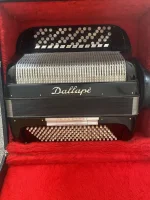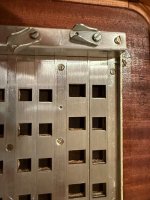Shaun_of_the_red
Member
I just acquired a well-used Dallape Organtone six-row, B-system accordion that has definite signs of being dropped in its 50+ year past. It was a pretty inexpensive purchase, so I'd like to try to do some of the repairs myself and if they fail, I can send it to a specialist to do a proper job.
Here is an issue I discovered that I think is making the bellows very inefficient at the moment. I removed the bass reed blocks from the plate they were pressed against and I removed the felted plate that keeps the register sliders in place, which gave me access to the screws that hold the base reed plate to the wood. One of the corner screws is missing and the hole is stripped (when I tried to screw in one of the other identical screws into that hole it just spun). There is a clear 1-2mm gap between that corner of the plate and the wood and I can push the corner down but it springs back up with or without the screw there. Seems like the obvious answer is to get a *slightly* larger diameter screw, but it's also obvious this has been an issue in the past because there are clear signs of work being done on this very hole: the metal around it is all scratched up from previous attempts at removing it. See the attached photos:
Here is an issue I discovered that I think is making the bellows very inefficient at the moment. I removed the bass reed blocks from the plate they were pressed against and I removed the felted plate that keeps the register sliders in place, which gave me access to the screws that hold the base reed plate to the wood. One of the corner screws is missing and the hole is stripped (when I tried to screw in one of the other identical screws into that hole it just spun). There is a clear 1-2mm gap between that corner of the plate and the wood and I can push the corner down but it springs back up with or without the screw there. Seems like the obvious answer is to get a *slightly* larger diameter screw, but it's also obvious this has been an issue in the past because there are clear signs of work being done on this very hole: the metal around it is all scratched up from previous attempts at removing it. See the attached photos:



